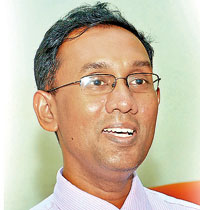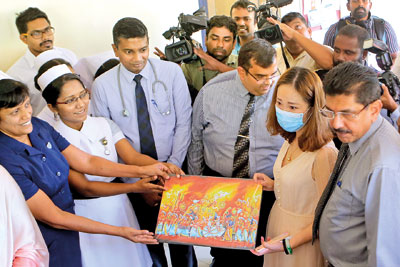News
Those early days of COVID-19 in Sri Lanka five years ago
View(s):- MRI’s National Influenza Centre gave ‘positive’ result in first case in just five hours, says Dr. Jude Jayamaha
By Kumudini Hettiarachchi
For Sri Lanka, January 27 was the day on which five years ago, the first case of COVID-19 was detected in the country.
Worldwide, the COVID-19 pandemic came about when cases of novel coronavirus (nCoV) were first detected in Wuhan, China, in December 2019, with the virus spreading rapidly to other countries.

Dr. Jude Jayamaha
Initially called the coronavirus disease 2019, it was later named Severe Acute Respiratory Syndrome Coronavirus 2 – SARS-CoV-2 and then COVID-19. By January 30, 2020, the World Health Organization (WHO) declared a Public Health Emergency of International Concern (PHEIC) and on March 11, 2020, characterised the outbreak as a ‘pandemic’.
A pandemic is defined as “an epidemic occurring worldwide or over a very wide area, crossing international boundaries and usually affecting a large number of people”. While 1,813,188 (over 1.8 million) COVID-19 deaths were reported in 2020, according to the WHO recent estimates suggest an excess death rate of at least 3,000,000 (3m).
In Sri Lanka, the first patient diagnosed with COVID-19 was a Chinese woman tourist and Consultant Medical Virologist, Dr. Jude Jayamaha, of the Department of Virology, Medical Research Institute (MRI) relives those tense moments.
“We detected the first case by an in-house real-time PCR (Polymerase Chain Reaction) assay on January 27, 2020,” says Dr. Jayamaha, explaining that the PCR method is widely used to make millions to billions of copies of a specific DNA (deoxyribonucleic acid) or RNA (ribonucleic acid) for detailed study. In the case of COVID-19, it was RNA from a nasopharyngeal swab of the patient.
The MRI’s National Influenza Centre was able to give the ‘positive’ result at 6.30 p.m. the same day, in just five hours after receiving the sample from the National Institute of Infectious Diseases (NIID), Angoda, and testing it twice even though countries in the region took much longer to do so.
No commercial kits were available for testing at this time, he says, appreciating the invaluable support of Hong Kong University (HKU) and Prof. Malik Peiris, Chair Professor of Virology of HKU’s Division of Public Health Laboratory Sciences.
He pays tribute to his colleague and Consultant Medical Virologist Dr. Janaki Abeynayake who did the sequencing of COVID-19 strains at the MRI.

Flashback to 2020 – the first to be detected with COVID-19 in Sri Lanka, the Chinese tourist, leaves for home with a memento from the staff of the NIID. Among those present were then Director-General of Health Services, Dr. Anil Jasinghe, and Consultant Physician Dr. Eranga Narangoda who treated her.
Two and a half years since January 27, 2020, the MRI had conducted more than 350,000 PCR tests including the first sequencing with regard to the first patient and also the first case of the second COVID-19 wave which erupted at a garment factory in Divulapitiya on October 6, 2020, says Dr. Jayamaha, explaining that the latter detection came after a lapse of a few months after the country was opened following the Presidential Election.
“The National Influenza Centre is a WHO designated respiratory laboratory and steps in during a national crisis to perform evaluations in a scientific manner from samples collected from around the country. Importantly, we detect false positives, by testing a variety of kits used by hospitals. Through a donation from the Rotary Club in May 2020, the centre introduced a fully-automated system to give results speedily,” he said.
Dr. Jayamaha goes onto list the achievements of the National Influenza Centre:
n By June 2020, the centre introduced antibody testing with assays provided by the WHO for COVID-19 to detect whether a person had been affected by the virus earlier.
n This was also the first government institution of the Health Ministry which began sequencing of COVID-19 strains thus helping to monitor the strains which were circulating at a given time.
n It also initiated the External Quality Assurance Programme (EQAP) to assess and strengthen the testing quality of other laboratories both government and private.
| Low prevalence of COVID-19 in 2023-24 The prevalence of COVID-19 is low, the MRI’s National Influenza Centre has confirmed after testing more than 11,000 samples from across the country in 2023-2024 to get the circulation patterns of viruses causing respiratory infections. The highest percentage of viruses doing the rounds were those of Influenza A and B, followed by rhinovirus, adenovirus and Human Metapneumovirus (HMPV), says Dr. Jude Jayamaha, adding that this confirmation comes from the strong National Influenza Surveillance Programme conducted year-round from sentinel sites across the country since 2007. These sites include 21 Outpatient Departments (OPDs) in state hospitals and 5 others where samples are collected from in-ward patients. The OPDs are those of the National Hospital of Sri Lanka (NHSL), Colombo; the Lady Ridgeway Hospital (LRH) for Children, Colombo; the NIID, Angoda; the Colombo South (Kalubowila), Colombo North (Ragama), Peradeniya, Karapitiya, Jaffna, Batticaloa, Kurunegala and Anuradhapura Teaching Hospitals and the Negombo, Nuwara Eliya, Matara, Vavuniya, Mannar, Chilaw, Polonnaruwa, Badulla, Ampara and Ratnapura Hospitals. The in-ward sites are at the NIID, LRH, Peradeniya Teaching Hospital and Negombo and Matara Hospitals. Meanwhile, the National Influenza Centre had recently won second prize at the annual academic sessions of the Sri Lanka College of Microbiologists for its study – ‘Two-year analysis of respiratory viruses in acute infections: Insight from a National Laboratory’. | |
The best way to say that you found the home of your dreams is by finding it on Hitad.lk. We have listings for apartments for sale or rent in Sri Lanka, no matter what locale you're looking for! Whether you live in Colombo, Galle, Kandy, Matara, Jaffna and more - we've got them all!

